Famous Erie Aviators, Digital Display Kiosk
Famous Erie aviators can be seen on a digital kiosk in the baggage claim area.
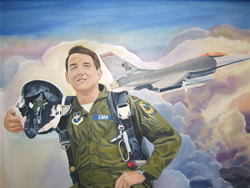
Major Thomas Carr
Born in Erie, Pennsylvania, on April 17, 1961, Carr was a 1979 Erie Tech Memorial High School graduate who excelled in the sport of wrestling. He was a State Junior Olympic wrestling champion as well as a State and Nation US Kids Wrestling Federation Champ. He attended Clemson University on a full wrestling scholarship and graduated in 1984 with a Bachelor of Science in electrical engineering.
He was a graduate of the Air Force Elite Fighter Weapons School where he was squadron leader, and one of the several hundred members of the elite Top Gun group. Major Carr had over 12 years of Air Force service, eight years of active duty and four years of reserve duty. In his military career, he was stationed in Korea, the Persian Gulf, Italy, Iraq, and Bosnia. He flew several missions around the world, including Operation Northern Watch in Iraq. After leaving active duty, Tom became an Air Force reservist and commercial pilot for American Airlines, stationed in Miami, Florida. Major Carr was the epitome of the citizen airman. He career reflected a distinctly genuine concern for his fellow warriors and he established the standard for all of those who selflessly dedicated their lives in the service of the United States Air Force. Major Carr upheld the finest qualities and the highest traditions of a combat aviator. He received numerous awards for his performance as a pilot. He sacrificed his life in the defense of his nation, and in the name of freedom. Major Carr lost his life on September 12, 1998 during an Air Force attack-training mission when his F-16D jet went down over the Avon Bombing Range in Florida.
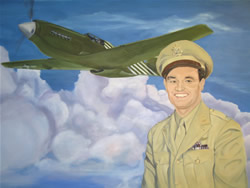
Colonel Philip G. Cochran
Born into a close Irish-American family in Erie, Pennsylvania in 1910, Philip G. Cochran made his was through college during the economic depression working odd jobs and singing in bands. In 1935, Cochran graduated from Ohio State University and entered Army pilot training in 1936.
He graduated to P-6s with the 33rd Pursuit Squadron on the 8th Pursuit Group at Langley Field, Virginia. In four years, Cochran rose from flying cadet to Squadron commander of the 33rd. Early in World War II, he played a major role in the build-up of fighter squadrons and the development of tactics to match the new fighters. Cochran would with fellow fighter leader Johnny Alison. He also spent time with the famed cartoonist Milton Caniff, who was an Ohio State graduate as well. Caniff even based his Terry and the Pirates character “Flip Corkin” on Cochran. During Operation Torch in North Africa, Cochran led the “Joker Squadron” of the 33rd Fighter Group in Army P-40s off the British Carrier Archer. Later he led the 58th Fighter Squadron of the 33rd Group in combat throughout North Africa. Colonel Cochran helped train and introduced into combat the first all-black 99th Fighter Squadron. He left North Africa with a reputation as a proven unorthodox combat leader. His North Africa fame earned him the attention of General Hap Arnold. General Arnold picked Cochran and Alison to lead project NINE, later called the 1st Air Commando Group. The top-secret mission of this composite group was to support British General Orde C. Wingate and his “Chindits” in Burma. Together, as part of Operation Thursday, the Chindits and Air Commandos accomplished the first actual night combat airfield seizure operation when they assaulted a jungle clearing and built Broadway Airstrip 165 miles behind Japanese lines. Nine thousand troops and tons of supplies were airlifted into Broadway in five days. The Air Commando composite force of fighters, bombers, transports, gliders, light planes, and helicopters provided reconnaissance, combat air patrol, air landing, air lift, interdiction, close air support, re-supply, and medevac to the Chindit force. Colonel Cochran later played part in the planning the invasion of France and Germany. He retired from the military in 1946 for health reasons. As the U.S. Air Force came into being, Milton Caniff started a new comic series called Steve Canton, in which Cochran was the role model for the character “General Philippe.” Cochran then worked for Howard Hughes’ RKO Movies as an aviation advisor. He managed some of the first jet filming ever attempted while flying copilot in a B-47 camera ship for the movie “Jet Pilot.” Later he returned home to Erie to serve in his brother’s business, Lyons Trucking. Over the years he rose to president of Lyons and helped expand it into a nationwide company. While serving his country, he earned the Distinguished Service Medal, Silver Star, Distinguished Flying Cross with three oak leaf clusters, Air Medal with four oak leaf clusters, Soldiers Medal, and British Guene with star and palm leaf. As an avocation, he took to riding and breeding horses. He died on horseback of a heart attack during a foxhunt at age 69.
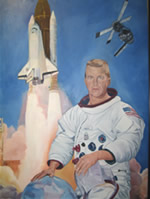
Paul J. Weitz
Born in Erie, Pennsylvania on July 25, 1932. He graduated from Harbor Creek High School and received a Bachelor of Science degree in aeronautical engineering from Pennsylvania State University in 1954. Weitz went on to receive a Masters degree in aeronautical engineering from the U.S. Naval Postgraduate School in Monterey, California in 1964. Weitz received numerous awards and received his commission as an ensign through the NROTC program at Penn State University.
He served for one year at sea aboard a destroyed before going to flight training and was awarded his wings in 1956. He logged more than 7,700 hours of flying time, 6,400 hours in jet aircraft. He served in various naval squadrons until he was selected as an astronaut in 1966. Mr. Weitz was one of just 19 astronauts selected by NASA in 1966. He served as pilot on the crew of Skylab-2, which launched on May 25 and ended on June 22, 1973. SL-2 was the first manned Skylab mission, and the first 28-day flight. The crew established what was then a new world record for a single mission, logging 672 hours aboard the orbital workshop. Weitz also logged 2 hours and 11 minutes outside of the spacecraft. He went on to become the Commander of the crew STS-6 that launched from Kennedy Space Center on April 4, 1983. This was the maiden voyage of the Orbiter Challenger. During this mission, the crew conducted numerous experiments in materials processing, recorded lightning activities, deployed IUS/TDRS-A, and conducted spectacular extra-vehicular activity while testing a variety of support systems in preparation for future space walks. With the completion of this flight, Paul Weitz logged a total of 796 hours in space. Weitz then moved on to become Deputy Director of the Johnson Space Center when he retired from NASA service in May 1994. He currently resides in Arizona.
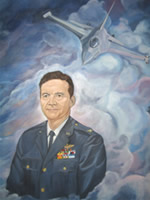
Colonel John Richard Boyd
Born in Erie, Pennsylvania January 23, 1927, John Richard Boyd lived at 514 Lincoln Avenue and attended Erie schools, graduating from Strong Vincent High School in 1945, where he had starred in water polo and swimming. He was a lifeguard under Frank Pettinato at Presque Isle Beaches. He went to the University of Iowa and graduated with a degree in Economics.
Boyd then went on to Georgia Institute of Technology and received a degree in Industrial Engineering. He served in World War II, Korea, Vietnam, and became an instructor at the fighter weapons school at Nellis Air Force Base in Nevada. He became known as “40 second Boyd” in simulated combat; if he couldn’t down you in 40 seconds, he would give you $40.00. He never lost in thousands of attempts. Recognized as one of the greatest military theoreticians of all time, Colonel Boyd wrote the aerial attack study on his own time. The Air Force had never had such a document. In 1960, it became the official tactics manual of the U.S. Air Force. It is still in use and also used by many other countries. He formulated the energy maneuverability theory (E.M.), which was the dividing line between the old and the new…used to define all characteristics of a fighter plane and those of a foe, to aid a pilot to determine his position of advantage. This theory was also used to define a fighter for specific purposes- before the plane was designed, or built. He was the “Father” of the F-15 and then the F-16; light weight, highly agile planes with very many new features and concepts. Over 4000 of these were produced to date and used by a considerable number of countries throughout the world. Colonel John Richard Boyd retired from the Air Force in August 1975 as a very highly decorated officer after a career filled with accomplishments. It has been claimed that he changed the Air Force. Retirement did not slow his passion for military theory. He began to study the techniques of way, starting with the author of “The Art of War”, Sun Tzu, written 2400 years ago. He studied all major battles and military theorists. From his many years of study, he produced his major and monumental study: “A discourse on winning and losing” incorporating “Patterns of Conflict”. These works also incorporated the now famous “OODA Loop” (Observe Orient Decide Act). His theories on war tactics have changed the way wars are fought and have been adapted by the U.S. Marine Corps and the U.S. Army. Tactics were employed in the Gulf War, Iraq fighting and Grenada. His theories are studied and taught throughout the world. His papers are housed in the Marine Corps Research Center in Quantico, VA. Colonel John Richard Boyd died in March 1997. His obituary was in the New York Times. He was buried in Arlington National Cemetery.
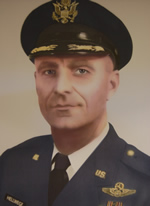
Colonel Richard “Dick” L. Hellwege
Colonel Richard “Dick” L. Hellwege was born on December 4, 1927 in Olean, New York. His family later moved to Erie where Dick attended Academy High School. He was an excellent swimmer. He set a State record in the 100 yard backstroke in 1944. Dick graduated from Academy in 1945.
In December 1944, Dick put plans to become a doctor on hold to enlist in the US Army. Because his Army IQ entry exam scores were so high, Dick was selected for the Army Specialized Training Program. He was ordered to Bolling Field in Washington, D.C. as the assistant director of physical training for the base personnel and those individuals assigned to the Pentagon.
While in Washington, a friend encouraged Dick to try for the pilot training program. Dick passed the entrance exam with “flying colors”! At 19, Dick went to Texas to begin pilot training at Randolph Field.
Colonel Hellwege mastered flying the F-84, the P-51, and the P-47. Just prior to the start of the Korean War, he transferred to the 78th Fighter Group at Hamilton Air Force Base in California and volunteered to go to Korea. He flew with the 8th Fighter Group and master flying the F-80C Jet. Colonel Hellwege was soon assigned to the F-86 (Sabre Jet) Unit of the 84th Fighter Interception Squadron. He and a group of other pilots formed the official Air Force jet acrobatic team-the Sabre Knights who would be later known as “the Thunderbirds”. The group flew many shows and entertained thousands with their acrobatic skills.
Following the last show on July 31, 1955, Colonel Hellwege requested a 2 to 3 year assignment with a US Navy Fighter Squadron. He quickly learned the intricacies of taking off from and landing on an air craft carrier. Colonel Hellwege became a centurion with over 100 carrier landings.
Over the next several years, Colonel Hellwege moved through a succession of senior staff positions at various Air Force bases. During this time, he attended college at night and on weekends. He graduated in 1961 with a Bachelors Degree in International Affairs and Geography from the University of California. Colonel Hellwege later earned a Masters Degree from George Washington University in the same field. He earned a second Masters Degree in Industrial Management from the National Defense University.
Colonel Hellwege retired from the United State Air Force on September 1, 1975. During his career he logged many flight hours in various fighters and received much recognition. His honors include two Distinguished Flying Crosses, five Air Medals, five Major Battle Stars, and a Meritorious Service Medal.
After retiring from the Air Force, Colonel Hellwege took a position with a major international manufacturer of aviation electronics. He retired from a senior executive position from that company in 1992. He lives in Southwest Florida with his wife of 35 years, Moira.
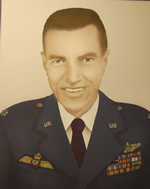
Lieutenant Colonel Magee C. Fuller
Lieutenant Colonel Magee C. Fuller was born in Erie, Pennsylvania on December 4, 1917 the son of Warren and Ethel Magee Fuller. He attended Emerson Elementary School and Gridley Junior High School. He graduated from Millcreek High School.
According to his sister, Magee always had an interest in flying. As a teenager, he took lessons at a small air strip located on Spires’ farm which is now the Millcreek Mall. Magee purchased a third interest in an open cockpit airplane and became a civilian pilot, a private flying instructor, and a charter pilot.
On his 18th birthday in 1935, Magee enlisted in the Pennsylvania National Guard. He was honorably discharged on December 3, 1938.
Always anxious to fly, Magee enlisted in the Royal Canadian Air Force on September 8, 1940. He was a flight instructor with the Royal Canadian Air Force stationed in Goderich, Ontario, Canada until May 1942.
On May 20, 1942, Magee was ordered to active duty from the Canadian Armed Forces to the Armed Forces of the United States commissioned 2nd Lieutenant stationed at Southeast Air Force Training Center, Maxwell Field, Alabama.
On June 6, 1943, Lt. Fuller was sent to England with the original 100th Bombardment Group (Heavy) at Station 139, Thorpe Abbotts, a tiny hamlet 20 miles sought of Norwich, England. He was with crew #7 assigned to the 349th Bombardment Squadron. The 100th Bombardment group concentrated its efforts against airfields in France and naval facilities and industries in both France and Germany. Lt. Fuller’s group acquired the nickname-“the Bloody Hundredth”. The group was the subject of the 1949 movie Twelve O’Clock High starring Gregory Peck.
Lt. Fuller rose to the ranks of Operations Officer, Squadron Commander for the 418th Bombardment Squadron. On March 4, 1944, Captain Fuller was the Command Pilot of the lead squadron of the first 8th Air Force Groups over Berlin.
On July 20, 1944 Lt. Major Fuller was leading a mission in a Pathfinder ship to hit oil refineries in Merseburg, Germany. The Pathfinder took a direct hit and Major Fuller was captured and taken prisoner near Louvain just east of Brussels. He was sent to Stalag Luft I located on a strip of barren land jutting in the Baltic Sea about 105 miles northwest of Berlin. Here Major Fuller remained a prisoner of war until liberated by the Russians in May 1945. After his release, Major Fuller returned to San Antonio, Texas on June 3, 1945. He separated from the Army Air Force on January 12, 1946. He applied for recall and was appointed a Reserve Officer in the United States Air Force. On July 1, 1955 Major Fuller was promoted to Lieutenant Colonel. He was a pilot stationed at various strategic air command (SAC) bases. He then worked as an air craft maintenance officer at retiring in August 1966.
During the course of his Air Force career, Lt. Col. Fuller earned many honors including: a Distinguished Flying Cross, an Air Medal with 4 Oak Leaf Clusters, 3 Overseas Bars, an EAME Theater Ribbon with 2 Battle Stars, and a Letter of Commendation. Lt. Col. Fuller was one of just a few officers authorized to wear the RAF Wings and the USA Air Force wings. Befitting a true hero, Lieutenant Colonel Magee C. Fuller died on July 4, 1970-Independence Day.
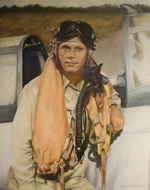
Robert Patterson LaFollette
Robert Patterson LaFollette was born May 23, 1920. He graduated from Erie Technical High School and was employed by Penn Union Electric as a metal pattern maker. When Pearl Harbor was bombed and the United States entered World War II, he entered cadet training in the U.S. Army Air Corps at San Antonio Cadet Center in Texas.
Flight training was divided into segments (i) Primary at Chickasaw, OK (light aircraft); (ii) Basic at Garden City, KS (more powerful aircraft and instruments); and (iii) Advanced at Eagle Pass, TX (AT-6 aircraft, instruments, retractable landing gear, then fighters). At the end of ten months of exhaustive training, he received his wings and was commissioned as a Second Lieutenant. Assigned to the 524th Fighter Bomber Squadron, 27th Group, he spent most of the war in the Italian theater. Being a fighter pilot was a solitary endeavor. Not only was he the pilot but also the navigator and the bombardier, responsible for all aspects of the flight, depending on his Crew Chief to see that necessary maintenance was performed and his Armorer to see that appropriate ammunition was loaded. As Squadron Commander, he was also responsible for the safety of the other pilots. Their job was to take out as many of the enemy and disable as many aircraft and transport vehicles as possible. Many missions were carried out at dawn with Allies coming out of the Sun to strafe or bomb aircraft, trains, and trucks before they could be camouflaged and hidden during daylight hours. They also performed escort duty, often clearing the way for the bombers. LaFollette was one of these courageous, resourceful, dedicated heroes. He became involved in the Battle for Anzio, supporting group troops attempting to cut the enemy’s main communications southeast of Rome and threaten the rear of the German XIV Corps. While the Allies avoided the destruction of religious and historic sites, the Germans recognized the strategic location of the Monastery of Monte Cassino, one of Christianity’s most sacred sites, as an essential component of German defenses overlooking the Liri Valley. Thus, it became a prime target during the battle for Monte Cassino and Allied bombs smashed it to rubble. It was later rebuilt with money provided by the United States. LaFollette was hit five times during the battle. Twice Captain LaFollette was able to nurse his plane back to base, however once he bellied the plane into Genoa harbor just past the shoreline approaching the Po Valley after trying to skip bomb a tunnel where flatcars were hidden and spent several hours in a dinghy before being rescued. He was shot down over Spezia. He once hit high-tension wires that became entangled in his propellers. The cockpit and crowbars had to be used to get him out. Making his way up the Italian “Boot” in a plane called Pinhead, Capt. LaFollette participated in the Italian Tactical Air Campaign in Operations: HUSKY, AVALANCE, ANZIO, MONTE CASSINO, STRANGLE, DIADEM, ANVIL-DRAGOON, PO VALLEY, and the Volturno Campaign. He was awarded the Distinguished Flying Cross when his squadron destroyed ten train locomotives. He earned many more awards, including seven Air Medals, the Army Presidential Unit Citation, the WWII Victory Medal, American Campaign Medal and the Armed Forces Expeditionary Medal, but for him and so many others, the primary reward was serving his country. During his tour, he became Squadron Operations Officer and flew many types of aircraft. For maneuverability, his favorite plane was the P-51 (the Mustang) and for endurance he favored the P-47 (the Jug). Although pilots were permitted to return to the States after 50 missions, he completed 102. On his return to America in 1947, while at Tindall AFB in Panama City, FL, Capt. LaFollette was Squadron Commander of the Pinball Outfit, which used to give gunners experience handling remote gunnery equipments. The gunner shot live ammunition at the training aircrafts, which were fitted with armor plates imbedded with sensors to record hits. The trainers returned fire with frangible bullets designed to pulverize on impact and record hits. However, some planes were actually shot down when the bullets malfunctioned. At the conclusion of the war, he was assigned to the Air Transport Command and flew war weary planes to Western bases. In 1947, he joined the Air Force Reserve and was assigned to Niagara Falls Air Force Base, flying with the “Weekend Warriors”, while transitioning to jet aircraft. As President of the Erie Chapter of the Air Force Association, he attended annual meetings in Washington, D.C., and received the Armed Forces Reserve Medal. Although LaFollette retired as a Major in 1977, he never lost interest in flying and kept track of Air Force technology, involving himself in annual air shows and attending group reunions.
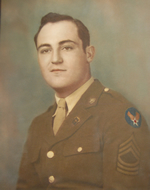
Master Sergeant Mario J. Filigenzi
It seems like destiny to be born on Veteran’s Day and die on Memorial Day. This is true of an authentic Erie hero. Master Sergeant Mario J. Filigenzi was born November 11, 1921 to Loreta Arduini Filigenzi and Dante Filigenzi. With his sisters, Louisa Filigenzi Battaglia and Theodora Filigenzi Cyone, Mario grew up in a close knit, resourceful family. He graduated from Academy High School in 1939 and enlisted in the air corps soon after his 18th birthday. He attended the Casey Jones School of Aeronautics in Newark, New Jersey and the G.E. School in Lynn, Massachusetts.
Mario always wanted to be a traveler and travel he did. By the time he was 20 years old, Mario had completely circumnavigated the globe in his B-17 as a member of the famed 19th bombardment group, the “Gypsy” 93rd squadron which participated in air battles over Java, Mindanao, Rabaul, New Guinea, and elsewhere in the southwest Pacific.
On August 7, 1942 in a bombardment mission over enemy territory near Rabaul, Master Sergeant Filigenzi and the rest of his formation were intercepted by a number of Zero type fighters. During the ensuing engagement, one engine and the oxygen system were disabled. In spite of these severe handicaps, flight engineer Master Sergeant Filigenzi operated the top turret guns. By his accurate firing, he warded off many enemy attacks, thus enabling the formation to complete the bombing run which resulted in the destruction of a large number of enemy aircraft on Vunakanau airdome.
For his many gallant efforts, Master Sergeant Filigenzi received many honors including the Distinguished Flying Cross and the Air Medal with four oak leaf clusters awarded to him for having completed 50 operational missions in flight against enemy fire power. He was the first World War II veteran from Erie to be awarded the Silver Star. He received commendations from Lt. General George C. Kinney as well as H.H. Arnold, General of the Army, Commanding General, Army Air Forces.
Master Sergeant Filigenzi and his squadron were featured in The National Geographic magazine in January, 1943. The exploits of his squadron were detailed in the book On Wings We Conquer by John Mitchel. “The Ballad of the Gypsy 93rd” was written to celebrate his squadron.
Although his flying almost cost him his life twice, Master Sergeant Filigenzi always returned to the skies to do what he loved most. Forty eight hours before he was to return home, Master Sergeant Filigenzi died in a plane crash on May 31, 1945 in England. Today the plot in which he rests is shared with his parents who outlived him by over 40 years.
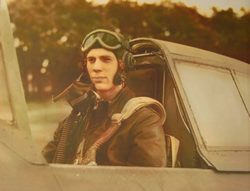
Major Earl L. Abbott
Major Earl Abbott was born January 8, 1919 in Springboro, Pennsylvania. Later his family bought a farm and settled in Harborcreek, Pennsylvania. Earl graduated from Harborcreek High School in May 1936. He then attended California State College. He studied to be a shop teacher.
When War World Two broke out, Earl enlisted in the Army Air Force. He graduated from Randolph Field in Texas on April 11, 1943. From Texas, Earl transferred to an Air Force base in Connecticut for more training. While training in Connecticut, Earl was hospitalized with meningitis. While in the hospital, he met an Army nurse named Florence Delucas. They would later marry in June 1944.
From the Air Force base in Connecticut, Earl was transferred to Bodney, England in July 1943 with the 352nd Group, Thunder Bolt Fighter Pilot. Major Abbott loved flying and flew over a hundred successful missions.
On January 24, 1945, Major Abbott piloted a P51 (Mustang) fighter plane on a fighter sweep mission from Asch, Belgium to Germany. He was last seen by the pilot of another plane at 2:15 pm northeast of Aachen, Germany in pursuit of an enemy aircraft. His plane appeared to be under controls at that time. That was the last time anyone saw Major Abbott and his plane. He was the only one of his group who did not return from the sweep.
Major Earl Abbott was awarded fifteen medals including a Silver Star, three Distinguished Flying Crosses and a Distinguished Flying Cross with 2 Bronze Oak Leaf Clusters, nine Air Medals, and a Purple Heart posthumous. Years later, remains of a plane were found near the site where Major Abbott was last seen. It has not yet been determined if the plane that was found is the same one that was flown by Major Abbott on that fateful day in January 1945. Major Earl Abbott is still classified as World War II Missing in Action. His sister in law Shirley Abbott still holds out hope that his remains will someday be found. She has spent many years and countless hours researching old military records in her quest to put Major Earl Abbott to rest.
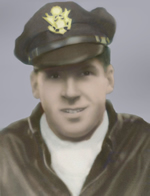
John Alexander "Jack" Siegel
John Alexander “Jack” Siegel was born in Erie on May 5, 1922. Son of Ella (Franz) and Edward Siegel, Jack grew up in Erie with his older siblings Richard “Dick” and Charlene (Petrucelli). He attended St. Joseph’s Elementary School and Academy High School, graduating in 1940. He attended Findlay College in Ohio for a time prior to marrying his high school sweetheart Geraldine Scibetta of Erie in 1942. Shortly thereafter, Jack enlisted in the United States Army Air Force.
After undergoing flight training in the South where he was recognized as an outstanding member of the select group which attained fighter pilot status, Jack accepted a commission as 2nd Lieutenant in 1944. He was assigned to the 356th Fighter Group, Eighth Air Force, stationed at RAF Martlesham Heath in England, where he flew combat missions in P-47 “Thunderbolts” and later in P-51 “Mustangs”.
Despite excellent leadership, the 356th (known as the “hard luck” fighter group) suffered the highest ratio of casualties to enemy aircraft “kills” of all Eighth Air Force fighter groups. The Martlesham P-51s flew more than 430 combat missions over Central Europe. For its role in “Operation Market-Garden” in the Netherlands, the 356th Fighter Group earned the rarely bestowed Distinguished Unit Citation. In addition to this honor, Jack personally earned the American Campaign Medal, a WWII Victory Medal, and Air Medal with one oak leaf cluster, the European-African-Middle Eastern Medal with 3 battle stars, and the Distinguished Unit Badge.
Having survived his experience as a fighter pilot, First Lieutenant Siegel returned to Erie in 1946 and resumed his college education at Edinboro College (now University). He had 2 children, John Jr. (1945) and Joan (1948) prior to the end of his marriage to Geraldine.
Jack subsequently rejoined the Air Force and flew fighters during the Korean conflict. He later met and married Lieutenant Margaret “Marge” Yelvert, R.N. while stationed at Scott AFB in Illinois where he was discharged in 1956. Following Marge’s discharge in 1965, the couple settled near Homestead AFB in Florida where Jack passed away on April 3, 1974.
In addition to Geraldine, John, and Joan (Bertolotti) who all reside in Northern California and Marge of Goldsboro, North Carolina; Jack is survived by sister-in-law, Frances (Bleil) Siegel of Erie as well as numerous Siegel, Scibetta, and Petrucelli descendants.
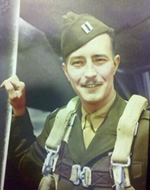
Lt. Colonel Carl J. Guerrein
“During the war, on several missions, the stress was so great that I completely gave myself up to God, telling him that I couldn’t handle the strain and he would have to guide my actions and course. At this point, I became recognized as one of the most fearless of bombardiers. God benevolently brought me home without injury.” This was the combat philosophy of young Erie native Carl J. Guerrein, the son of Carl C. Guerrein and Edith Arndt Guerrein.
Guerrein’s distinguished military career, rising from enlisted private to Lt. Colonel, started after graduation from Erie Academy High School and enlisting in the Army Air Corp Dec. 7, 1942. He became part of the 8th Air Force 388th Bomb Group flying the B-17. Guerrein flew 33 combat missions as a bombardier with 235 hours flight time; he was both division wing and lead bombardier, predominately with the crew of “Heaven’s Above.” He was awarded the Distinguished Flying Cross, Air Medal with Four Oak Leaf Clusters for heroism, the European Campaign Medal with Silver Star, the World War II Victory Medal and was a member of the “LUCKY BASTARD’S CLUB,” bestowed by fellow airmen who had survived 25 missions. Guerrein also received an Army Commendation Ribbon in 1946.
Post war, his assignments included Director of Air Reconnaissance with the Alaskan Theatre Air Command; Chief of Plans and Programs for the Air Research and Development Command (original cadre of the Strategic Air Command); and Plans and Program officer for the Joint Chiefs of Staff at the Pentagon, from which he retired. Guerrein amassed 4,600 hours of total flight time and maintained his flight status well into his administrative career, earning the Master Navigator title in 1960.
His 25-year- career spanned the wars of WWII, Korea and Vietnam as well as the Cuban Missile Crisis. He gave his best to the military, moving over 12 times, crisscrossing the country with each new assignment.
He was buried in Arlington National Cemetery with full military honors. Lt. Colonel Guerrein’s blue wool flight suit, circa 1950, rugged looking after 1,500 hours of flight time, is part of a display at the National Museum of the USAF at Wright-Patterson AFB.

Colonel Robert MacDonald Fry
“He was the best pilot of them all, deadly in dive-bombing and as honest as the day was long”. This is how Captain Franklin Luckman once described Colonel Robert Fry, a fellow member of the 365th Fighter Group, 388th Squadron, otherwise known as the “Hell Hawks”.
Robert MacDonald Fry was born in Erie on July 3, 1921. During his youth, he enjoyed sailing the waters of Lake Erie. Upon graduation from Strong Vincent High School in 1939, Fry headed to Annapolis as a midshipman.
After Pearl Harbor, Fry was offered pilot training. He left Annapolis in 1943 during his junior year and accepted an immediate commission and assignment to flying school. Fry opted for the Army Air Forces and earned his wings in mid-1943 just in time to join the 365th in Richmond. Fry rose to command the 388th Squadron and finished the war as the Hell Hawks top ace flying the P-47 Thunderbolt and credited with 7 victories (the Air Force reduced the official number to 4 after the war) earning many decorations and honors including: the Distinguished Service Cross ad Distinguished Flying Cross with oak leaf cluster, the Silver Star, the Soldier’s Medal, the Legion of Merit, the Air Medal with 5 silver oak leaf clusters, the blue ribbon, the British Distinguished Flying Cross, and the Belgian Croix de Guerra. He flew everything from F-89s, T33s, C-119s, and B-57s. He retired in 1969 as a full Colonel.
Col. Fry married Betty Lou Shafer of Erie on April 5, 1945 while home on leave. Together they had 2 sons, Charles, a Colorado State Trooper killed in the line of duty on September 26, 1987 and David, a retired US Marine Lieutenant Colonel who now resides in Arizona. Betty Lou passed away in 1970 and Col. Fry later married Patricia Nan Weber. They resided in Annapolis where Col. Fry once again enjoyed his love for sailing. He continued to sail until his death on May 7, 1985. Col. Fry’s ashes were scattered on the Chesapeake Bay.

Lieutenant Colonel Kenneth Leroy Gardner
Kenneth Leroy Gardner was born in Erie on January 19, 1934 to Lloyd Emerson Gardner and Martha Krasnesky Gardner. He is a graduate of Erie private schools and attended Gannon College where he majored in chemistry. He joined the Air Force in October 1953 and received his commission in 1954 after a period in the aviation cadets. Kenneth Gardner married Ruth Eileen Baker in 1960. Together they had 2 sons and 2 daughters.
Kenneth Gardner was an Air Force fighter pilot in Vietnam. His many medals included the Distinguished Flying Cross with one Oak Leaf Cluster, Air Medal with 10 Oak Leaf Clusters, Combat Readiness Medal, Good Conduct Medal with four Oak Leaf Clusters, National Defense Service Medal, Vietnam Service Medal with two Bronze Service Stars, Republic of Vietnam Campaign Medal and the Armed Forces Reserve Medal. The citation which accompanies his Distinguished Flying Cross reads:
“Captain Kenneth L. Gardner distinguished himself by heroism while participating in aerial flight as an F-105 pilot in North Vietnam on December 15, 1965. On that date, while attacking a vital power supply point deep within hostile territory, Captain Gardner and his flight leader received direct hits to their aircraft resulting in the downing of the lead aircraft and severe damage and fire to his own aircraft. With complete disregard for his own personal safety, Captain Gardner aided in the successful rescue of his fallen companion and then flew his stricken aircraft safety back to friendly territory. The outstanding heroism and selfless devotion to duty displayed by Captain Gardner reflect great credit upon himself and the United States Air Force.”
Kenneth Gardner retired as a Lieutenant Colonel from the Air Force on February 1, 1974 after 20 years of service. Upon retirement for the Air Force he worked as a guidance counselor with the Sumter County Career Center in Sumter, South Carolina. Lt. Col. Kenneth Gardner died on May 29, 2010 and is buried in Arlington National Cemetery.
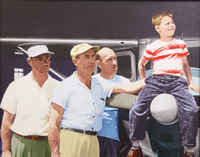
Kudlak Brothers: Michael, Andrew, and Joseph
Andrew Kudlak was born on December 16, 1911 in North Tonawanda, New York. His younger brothers, Michael and Joseph were born in Austin, Pennsylvania on September 18, 1913 and March 4, 1918, respectively. The Kudlak family moved to Erie in the late 1920’s after a major flood in Austin. All three brothers graduated from East High School and earned their pilot’s licenses shortly thereafter.
After graduating high school, Andrew entered the US Army Air Force during World War II and was assigned as a fighter pilot instructor. Michael joined the US Army Air Corps in 1942. He taught US Army Air Corps pilots to fly and was the chief flight examiner for his base. Joseph entered the US Air Command during World War II. He was a crew chief on a B-29 and taught B-29 maintenance procedures. After being honorably discharged from the service, all three continued with careers in flying. The brothers purchased the Erie County Airport in 1946 and built two hangars and an administration building. Their operation was called Erie County Flying Service with Michael as President, Joseph as Vice President, and Andrew as Secretary-Treasurer, Chief Pilot, and Flight Examiner. Services offered at Erie County Flying Service included a flight school, corporate flight services, and aircraft sales and service. They were the only flight school with authorized training for flight in Instrument Flight (IFR) conditions within 200 miles and were the Civil Aeronautics Board authorized instructors for the approval of Instrument Flight licenses required for commercial pilots.
Their operation was so successful that the Kudlak brothers moved their operation to the Port Erie Airport in 1957 and their business was renamed Erie Airways, Inc. During the next 20 years, the Kudlak brothers built hangars and expanded air taxi operations, air charter operations, aviation fuel sales, and line services for general aviation aircraft and air carrier service. Erie Airways, Inc. also provided aircraft rental and sightseeing services, repair and maintenance of aircraft, the sale of aircraft parts, and US Government contracts for aerial survey. They furnished corporate flight services for large Erie based companies including: Hammermill Paper Company, General Electric, Lord Corporation, Zurn Industries, and AMSCO among many others.
The Kudlak brothers were true aviation pioneers in the State of Pennsylvania. They were one of the original general aviation pilots and developers of the full service Fixed Based Operator (FBO) industry in the United States. The vision and leadership of Michael Kudlak with his brother Andrew and Joseph helped facilitate the growth of both general and corporate aviation operations at the Erie International Airport. To recognize these contributions, the Airport Authority passed a resolution on August 20, 1979 applauding Michael Kudlak’s 22 years of leadership in the field of general aviation and the resulting benefits to the aviation community. On August 12, 1983 the Millcreek Township Supervisors held a dedication ceremony for the naming of Kudlak Drive, the road behind the Erie Airways hangars off of Asbury Road.
Joseph Kudlak passed away on January 3, 1981.
Michael Kudlak passed away on May 5, 1983.
Andrew Kudlak passed away on May 12, 2012.
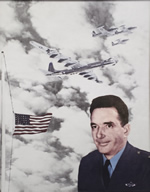
Brigadier General Richard Elmer Ellsworth
Richard Elmer Ellsworth was born on July 18th, 1911 the third of four children born to Elmer and Edna Ellsworth of Erie Pennsylvania. He grew up in Erie attending Erie Academy. After high school he joined the Pennsylvania National Guard from which he earned an appointment to the USMA West Point. He graduated with the class of 1935 as a cavalry officer but applied for pilot training becoming a rated pilot in 1936.
From 1936 to 1941 he was stationed at Mitchell field, Kelly field and the Sacramento Air Depot. In 1941 he earned a Master’s Degree in Meteorology from California Institute of Technology.
After a short tour as a transport pilot in Alaska, he was assigned to the South Pacific to coordinate weather matters for the Army Air Corps.
In 1943 he attended Command and General Staff College at Fort Leavenworth. In July 1943 he was assigned to the China Burma India Theater or CBI.
Dick arrived in India in August 1943 and was designated as the Regional Control Officer for the 10th Weather Region and Commanding Officer of the 10th Weather Squadron. This assignment thrust him into the middle of many difficult problems that confronted the Army Air Corps in the Far East and gave him the opportunity to contribute greatly to the prodigious air supply operations over the “Hump” and into China. With China cut off from the outside world, except for the air route over the Hump, both General Chennault and Generalissimo Chiang Kai-shek were determined to use every pound of airlift capacity for desperately needed supplies and vigorously opposed Dick’s plan to ship weather forecasters and observers into China. His persistence resulted in the acceptance of his plan. Not only were weather stations established along the Hump route, but weathermen came to operate behind the Japanese lines, both in China and Southeast Asia.
As a squadron report for the period indicates: Most of the pushing, the planning and even the paperwork was done singlehandedly by the Colonel himself. This period saw the establishment of the India and China Weather Centrals, which provided long forecasts for the B-29 bombing missions.
While assigned to the CBI Theater, Dick flew 400 combat missions, most of them in a 10th Weather Squadron C-47. He helped pioneer the establishment of regular night flights over the Hump. For his achievements while serving in the CBI Theater, Dick was awarded the Distinguished Flying Cross with a bronze oak leaf cluster; the Legion of Merit; the Air Medal with two oak leaf clusters and the Commendation Ribbon.
In 1945, Dick was reassigned to Headquarters, Air Weather Service (AWS) in Washington, D.C. as Chief of Operations and Training Division. With the numerical strength and number of weather stations operated by AWS dropping rapidly, he was instrumental in maintaining the Weather Service at a high level of efficiency. In the words of the Weather Service Commander, Colonel Donald N. Yates, in a letter of commendation: “The continuing efficient functioning of the Weather Service could not have been possible except for the success of Colonel Ellsworth’s long-range plans and forecasts of future needs.”
In 1946, Dick left Headquarters AWS to activate the 308th Reconnaissance Group (Weather) at Morrison Field, West Palm Beach, Florida. In June 1947, the group moved to Fairfield-Suisun Air Base in California, and for the next two years, under Dick’s command, provided weather reconnaissance of the West Coast, trained new weather reconnaissance aircrews and units, and accomplished such special projects as the Ptarmigan weather reconnaissance flight over the North Pole.
Dick left the 308th in 1949 to attend the Air War College. On graduation, he was assigned to the Strategic Air Command, first as Chief of the Plans Division, at Headquarters Second Air Force, Barksdale AFB, Louisiana and then in 1950 to the 28th Strategic Reconnaissance Wing, at Rapid City AFB, South Dakota. He served as Wing Commander and then as Commanding General of the Base. His promotion to Brigadier General came on September 5, 1952 at the age of 41.
On the morning of March 18, 1953, just after midnight, the B-36 on a low level mission from the Azores to Rapid City, testing our radar defenses, encountered a freak weather pattern causing the aircraft to reach landfall well before the estimate. The resulting crash near Nut Cove Newfoundland killed General Ellsworth and 20 other crew members.
The people of Rapid City petitioned the Congress to rename the base. It was dedicated as Ellsworth AFB in June 1953 by President Eisenhower. General Ellsworth was greatly loved and admired by all who served with him and under his command.
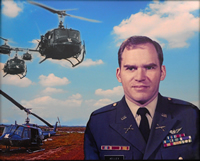
Lieutenant Colonel Robert D. Kelley
Robert D. Kelley was destined to become a pilot. In 1964, with -72F below zero field artillery exercises in Alaska, a 9.2 earthquake, and coming from a family rich with aviation history, he decided it was “time to fly”.
Bob was born in Erie on January 14, 1939, to John J. Kelley and Helen Kudlak Kelley. He graduated from Cathedral Prep in 1956, Gannon College in 1961 with a BA in Chemistry, Bob was commissioned in the United States Army after graduating from Gannon. He completed fixed wing training in 1965 and finished second in his class. He then completed helicopter training in 1966 at Fort Rucker, Alabama. He served two tours in Vietnam as an Army Aviator. During his first tour in Vietnam in 1967, with the 118th “Thunderbirds”, he was shot down and was taken off flight status for a year because of his injuries. He was hospitalized at Walter Reed Medical Center for five months. He was awarded the Distinguished Flying Cross for his actions at Soui Da, Republic of Vietnam. The citation states:
“For heroism while participating in aerial flight evidenced by voluntary actions above and beyond the call of duty: Captain Kelley distinguished himself while participating in a combat assault near Soui Da, Tay Ninh Province, Republic of Vietnam. The flight descended on final approach through a withering barrage of Viet Cong automatic weapons fire. As he landed earthshaking explosions shattered the landing zone while enemy small arms fire raked the area. The initial blast enveloped his ship and debris riddled it with shrapnel. He received serious shrapnel wounds in both legs and fought to control the severely damage aircraft. His aircraft was literally blown into the air and the controls were so badly damaged that it could not be landed immediately. Despite his painful wounds, he assisted in flying the extensively damaged aircraft. A complete hydraulic failure was experienced shortly after the ship became airborne. With the controls of the aircraft rapidly becoming more and more difficult to manipulate, a successful forced landing was made in an open field. Just as the ship was landed the cyclic control mechanism failed completely. His courage and determination in face of the imminent disaster, while suffering from painful wounds, was a tremendous inspiration to all who participated in the assault. His actions were in keeping with the highest traditions of the military service and reflects great credit upon himself, his unit and the United States Army.”
During his second tour in 1971, Bob was the Commander of the 128th Assault Helicopter Company. The unit was comprised of 450 officers and men with 30 helicopters and eight gunships. His military medals include the Senior Army Aviator Badge, Legion of Merit, Distinguished Flying Cross, Bronze Star, Air Medal with sixteen Oak Leaf clusters, Joint Service Commendation Medal, Army Commendation Medal, Purple Heart, and several Vietnam service medals.
Bob retired from the Army in 1983 as a Lieutenant Colonel and worked as a contractor for the Central Intelligence Agency and the National Reconnaissance Office. He worked on the future design of optics and target signatures for future aircraft and space platforms. He flew both aircraft and helicopters to complete these missions.
Bob Kelley currently lives in Vienna, Virginia with his wife Pamela Jean Severance of Erie whom he married on June 30, 1962. They have three sons Scott, Sean and Patrick who live in Northern Virginia, and five grandchildren and two great grandchildren.
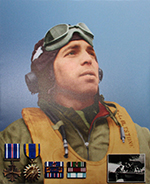
First Lieutenant Harry L. Blystone
First Lieutenant Harry L. Blystone was born in Girard, PA on October 30, 1918; the son of Mr. and Mrs. Leon G. Blystone. After graduating from Edinboro High School, Blystone enlisted in the Army Air Corps in 1941 and was sent to the Air Corps Technical School. He excelled as a mechanic and was quickly promoted to corporal then sergeant by May of 1942. The Army Air Corps sent him to flight school at Moore Field in Mission, Texas.
From there, Blystone went on to fighter pilot school where he was commissioned as a Second Lieutenant. Upon completion of his training, Second Lieutenant Blystone was sent to England as a P-47 (Thunderbolt) pilot. He was eventually commissioned as a First Lieutenant. During World War II, Lt. Blystone completed 88 flying missions in Germany and France; with the majority of them being voluntary as only 32 missions were required. During his missions, Lt. Blystone shot down 2 Nazi fighter planes. He and his group escorted B-17s (Flying Fortresses) and B24s (Liberators) to targets deep within Germany. As reported in one newspaper publication:
“In recognition of his excellent combat work since the invasion of Europe began, First Lieutenant Harry L. Blystone, North Girard, has been named a squadron commander in the crack P-47 Thunderbolt group based in England. He shared in the destruction of four locomotives and two training planes and has bombed and strafed a railroad station and several freight cars while flying in close support to the Allied land armies. Lt. Blystone has also attacked 20 barges in one mission, scoring numerous hits and inflicting heavy damage which hindered the supply lines of Nazi troops moving up from the interior of France.”
For his many successes, Lt. Blystone earned the Distinguished Flying Cross with one Oak Leaf Cluster, the Air Medal with 3 Oak Leaf Clusters, and various European Campaign Medals for Meritorious Achievement. He later returned to the United States and became a P-51 (Mustang) pilot instructor. After the war ended, Lt. Blystone was discharged from the Army Air Corps and spent the next 20 plus years in the US Army Reserves. He raised a family with his wife Beverly in both Erie, PA and Kane, PA. Their son Jack graduated from the Air Force Academy and daughter Nancy served in the Air Force for 4 years, retired from the US Army Reserves as a Lieutenant Colonel, was the Chief Nurse in the 382nd Combat Support Hospital, and holds a Master’s Degree in Nursing Administration. First Lieutenant Harry L. Blystone died May 10, 1996.
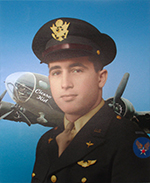
First Lieutenant John J. Chimenti
First Lt John J Chimenti (service number 0-818111) was killed in action over Fouches, Belgium on November 9, 1944 (his 33rd mission) while piloting his B-17 Flying Fortress Bomber on the Mission 223 bombing run (embarking from his base at Station 136, Knettishall, England) to the Marshalling Yards and Rail Facilities of Saarbrucken, Germany. His B17 Flying Fortress (christened: The Cicero Kid-commemorating his father's sister's family) was a member of the 388th Bomb Squadron, 8th Air Force of the US Army Air Force, 3rd Air Division, 45th Combat Wing, 563rd Bomb Squadron.
Over Fouches, engine #4 caught fire (from enemy gunfire) causing a violent explosion breaking the plane into three parts perishing him and his co Pilot, 1st Lt. James P. Clark. The other seven-crew members parachuted to safety. This was first of three additional missions he wanted to complete before being released.
His heroism, co Pilot and squadron are honored in a plaque (including pictures) on a monument at Arlon Military Barracks (Fouches) inaugurated by the Belgian citizens at the commemoration of the 65th Anniversary of the Battle of the Bulge [December 12, 2009]. Its dedication focuses on all crews of the 8th and 9th US Army Air Forces that served to liberate Belgium during World War II.
John Joseph Chimenti was born on November 28, 1920 at 304 East Fifth Street, Erie, Pennsylvania to Rosina Filippo (1891-1964 and Natale Chimenti (1881-1964) (both immigrants from San Lucido, Italy). He was the youngest of seven siblings: Joseph (1909-1960, married Kathryn Herbo 1946-2003), Helena Margaret (1912-1991 married Giuseppe Alo, 1928), Albert (1913-2003, married Kathryn Lucille Wylie 1940), Armand (1915-1985, married Martha Daniels, 1940-1950; Irene Radziszewski -1952-2008), Ida Marie (1917- 1988, married Harold Clements, 1943), Yolanda (Helen 1919-1991, married Albert Scalise, 1947.
John J. Chimenti, an honor graduate of Class of 1938, Erie East High School, was awarded Stanford University Scholarship to study Civil Engineering. He played football at both schools. On January 12, 1940, he was accepted into Stanford's distinguished Kappa Sigma fraternity (the very first fraternity in USA). He enlisted in the US Army Air Corps on August 14, 1942. He is buried in Calvary Cemetery beside his parents .
Prepared June, 2016,by (nephew) Richard A. Alo', PhD, Dean, College of Science, Engineering and Technology, Jackson State University
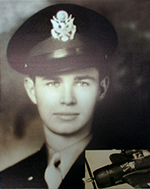
Colonel William S. Hurley
Colonel William (Bill) S. Hurley was born in Erie, PA on September 9, 1921. Bill graduated from Strong Vincent High School in 1940 and enrolled at the University of Pittsburgh where he eventually graduated with a Bachelor of Science in Mechanical Engineering, majoring in Aeronautical Engineering. After the Air Force, Bill owned and operated his own engineering consultant office in Cleveland, OH for many years. After the Japanese attached Pearl Harbor, Bill left college to enlist in the Army Air Corps on May 8, 1942. As a member of the 361st Squadron, Bill flew 86 combat missions. He flew the P47 and P51; both were named the Eerie Eagle.
During World War II, bill was promoted to Captain and earned the Distinguished Flying Cross, the 8 Oak Leaf Cluster Air Medal, EAME Theatre Medal with 5 Battle Stars, WWII Victory Medal, and the American Campaign Medal. Bill flew in the following battles: European Air Offensive, Invasion of Normandy, Northern France, and the Ardennes Campaign and the Rhineland. Bill was part of the 356th fighter group that was awarded the Presidential Unit Citation for the Ardennes Campaign.
After WWII, Bill went on to fly Air Exhibitions in the Flying P51s. He was in the first Jet Fighting School in the United States (Williams Air Force Base and March Field, CA) and the first class to fly the P80 Shooting Star. Bill flew, as part of this Jet Fighting Squad, the first mass jet flight in history from March Field, CA to Andrews Air Force Base in Maryland. He was promoted to Major and subsequently left the Air Force to finish college at the University of Pittsburgh. As a reserve officer, Bill continued to fly and was subsequently retired from the United States Air Force (USAF) as a Colonel in 1986.
The Erie Daily Times published several articles about Colonel Hurley’s successes in the war. As noted in one article:
“On July 17, 1944, W.S Hurley faced 4 to 1 odds. As stated in the article, as the Germans were attacking from behind, Hurley turned sharply and met the Jerries straight on. The exchanged blast for flast until Hurley’s bullets smashed into the German’s wings and fuselage. As the German plane fell, the other German planes turned and fled. This exchange occurred on Hurley’s 19th trip across the English Channel.”
Bill’s personal life was complete when he met and married his love, Mary Pat McHugh a graduate of Cincinnati College. They went on to have 5 children: Susan, William, James, Thomas, and Sally. Bill and Pat retired to Virginia Beach where Bill continued to fly. His last pilot’s license renewal being at the age of 90! He was looking for a plane to purchase up until his death in January 2015 at the age of 93. Bill and his wife are buried at Arlington National Cemetery with full military honor and two flyovers- one in a P51 with Eerie Eagle painted on the side and the other the traditional Jet flyover.
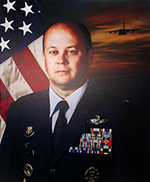
Colonel James Allen Regenor
Colonel James Allen Regenor was born in Erie, PA, on April 8th 1964. He is the son of Mr. Jon A. Regenor and Mrs. Marilee E. Agostini, and the stepson of Mr. Louis J. Agostini. Colonel Regenor received his education from the Sisters of Mercy at St. Luke and Mercyhurst Preparatory Schools where the sisters encouraged his curiosity and sense of adventure. His passion for flight was sparked right here at the Erie International Airport where as a young boy he would attend airshows with his family. He would marvel at the precision aerobatics of the U.S. Air Force Thunderbirds as they performed and dream about flying. He enlisted in the U.S. Air Force on January 20th, 1982. Initially, Colonel Regenor entered the Air Force as an enlisted crewmember on a Titan II Missile Combat Crew in the Strategic Air Command.
As an Airman First Class, he was selected for a program that allowed enlisted members to compete for an appointment to the United States Air Force Academy. Colonel Regenor graduated from United States Air Force Academy in the class of 1988. He attained flight qualifications as co-pilot, aircraft commander, instructor pilot, and evaluator pilot in the Strategic Air Command, Air Mobility Command, and the Air Education and Training Command. Colonel Regenor was selected for command three times. First as the squadron commander of the Fightin’ Fourth Airlift Squadron, McChord Air Force Base, Washington; then as the squadron commander of 817th Expeditionary Airlift Squadron; and last, as the group commander of the 521st Air Mobility Operations Group, Naval Station Rota, Spain.
He flew combat and combat support missions in during Operations DESERT SHIELD, DESERT STORM, PROVIDE COMFORT, NORTHERN WATCH, SOUTHERN WATCH, PROVIDE PROMISE, PROVIDE HOPE, SHINING HOPE, ENDURING FREEDOM, and IRAQI FREEDOM, and provided air refueling, air mobility, airdrop, primary nuclear airlift, and aeromedical evacuation support during the wars in Iraq, Afghanistan, Bosnia, and Kosovo. His staff tours include the Joint Staff (J-3), Headquarters U.S. Air Force Air Staff, CHECKMATE and Current Operations Divisions, and U.S. Strategic Command Joint Forces Component Command Integrated Missile Defense (J-5 & J-7). Colonel Regenor was also selected to serve as the Deputy Executive Secretary, National Security Council, Executive Office of the President, for Presidents Bush and Obama.
Colonel Regenor is a command pilot with over 4,100 flying hours and 400+ combat / combat support hours in the T-37, T-38, KC-135R and C-17A. He has been award multiple medals, campaign ribbons, and service ribbons. Most notable are two Defense Superior Service Medals, the Legion of Merit, the Defense Meritorious Service Medal, four Air Force Meritorious Service Medals, two Air Medals, two Aerial Achievement Medals, Joint Meritorious Unit Award, eight Air Force Outstanding Unit Awards (one with Valor). Colonel Regenor served our nation with distinction for 31 years.
Colonel Regenor attributes his success to the Airmen he served with and to the lessons he learned in the “crucible of courage” …the wrestling rooms where he learned to wrestle in his youth. Colonel Regenor is married to the former Sherece L. Shultz of Orland, California, and they have two children, Keaton Allen Regenor and Amelia Caroline Regenor. Colonel James Allen Regenor is a proud son of Erie!
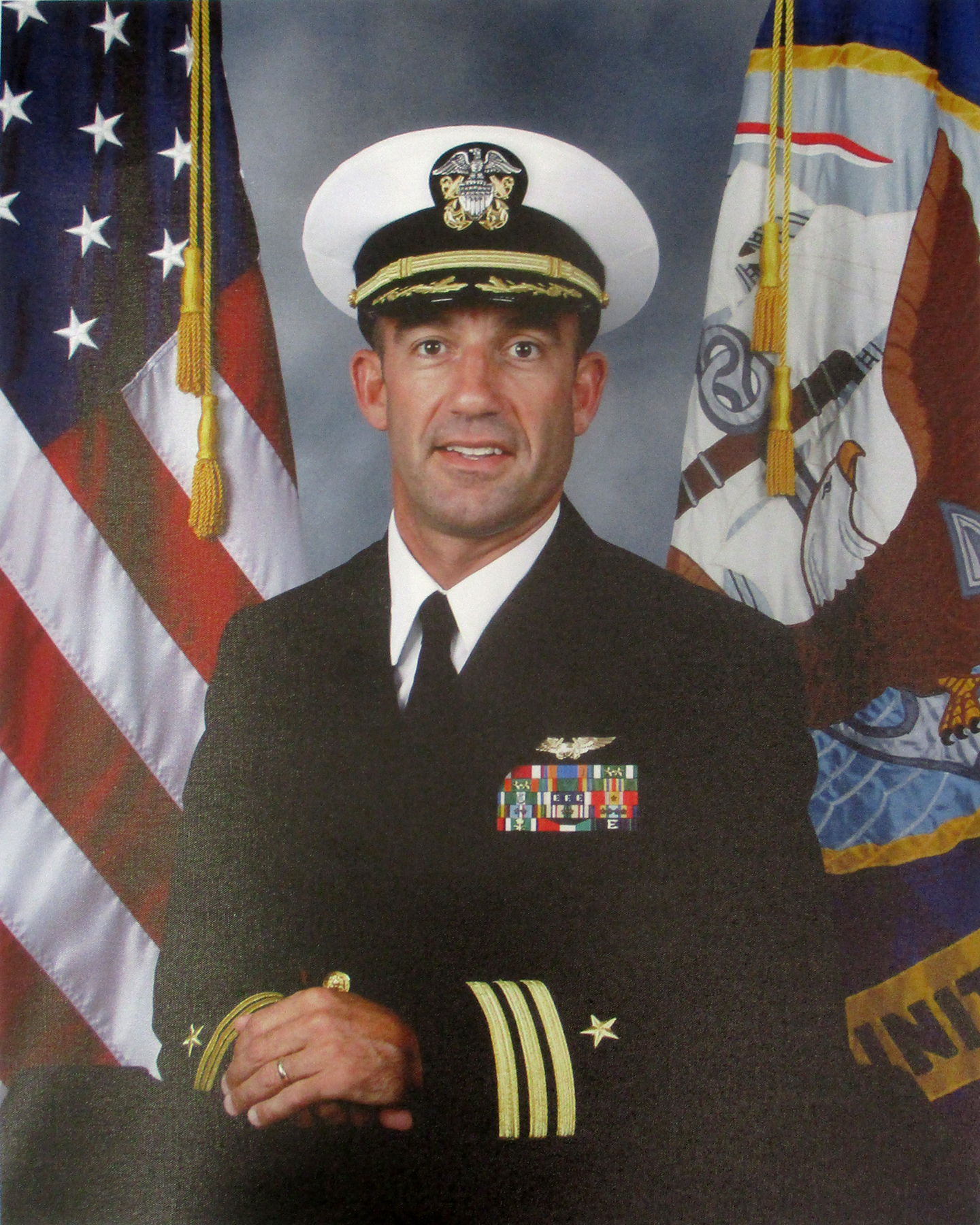
Captain Brian Whitten
Captain Brian “Stitch” Whitten was born in Erie, Pennsylvania on July 7, 1963 son of Robert and Phyllis Whitten. Interested in aviation from an early age, he began taking flight lessons as a teenager while flying a two-place Stinson taildragger at Moorhead Airpark. He graduated from North East High School in 1981 where he was a standout student and athlete, including five State Championship medals in track. Brian went on to compete for the track team at Cornell University, becoming a 3-time Ivy League team champion, and graduated in 1985 with a Bachelor of Science degree in Natural Resources.
Intent to pursue his flying career further, he entered the United States Navy Aviation Officer Candidate School, finishing second in his class, and was commissioned an Ensign in June 1987. He promptly commenced flight training at Training Squadron Ten (VT-10 Wildcats), Naval Air Station, Pensacola, Florida, and was ultimately designated a Naval Flight Officer in June 1988 at Naval Air Training Unit, Mather Air Force Base, Sacramento, California.
During the course of a twenty-eight year naval career flying primarily the P-3C patrol plane aircraft, Captain Whitten attained flight designations to include Mission Commander, Tactical Coordinator Instructor, and Fleet Weapons Tactics Instructor. His operational flying tours included assignments to Patrol Squadron FOUR (VP-4 Skinny Dragons), Naval Air Station Barbers Point, Hawaii, and Patrol Squadron FORTY (VP-40 Fighting Marlins), Naval Air Station Whidbey Island, Washington. He completed five deployments to various sites in the western Pacific and Indian Oceans regions and flew twenty-two combat strikes and combat support missions during Operation DESERT STORM. He was Commanding Officer of Training Squadron TEN (VT-10 Wildcats), Pensacola, Florida, from July 2006 to May 2008 where he was entrusted as the lead instructor for all aspiring flight officers during their initial basic and intermediate flight training. During his tenure, Captain Whitten personally presented 316 young men and women their “Wings” designation, and allowed them to proceed to advanced flight training and further military flying careers. Captain Whitten has over 3,100 flying hours in numerous airframes to include the P-3C, T-1, T-6, T-34, EA-6, S-3, F/A-18, F-15, and T-38.
Captain Whitten’s staff tours included assignment to the nuclear aircraft carrier USS Nimitz Tactical Action Officer, Bremerton, Washington; Patrol Wing TEN Weapons System Trainer, Officer-in-Charge, NAS Whidbey Island; Office of the Chief of Naval Operations Flight Training Requirements Officer, Pentagon; and Executive Officer to the Deputy Commander for Military Operations at U.S. Africa Command, Stuttgart, Germany. He also completed a Master of Science degree in Information Technology Management from the Naval Postgraduate School and a Master of Science degree in National Resource Strategy from the Industrial College of the Armed Forces.
Personal awards include the Defense Superior Service Medal, Meritorious Service Medal (2 awards), Navy Air Medal (First Strike), Navy and Marine Corps Commendation Medal (3 awards), Navy and Marine Corps Achievement Medal (3 awards), and various unit awards and campaign medals.
Erie International Airport is of special significance to Captain Whitten. His first impressions of aviation were made from an attic bedroom window that overlooked its runways at his home at 4642 West Lake Road. He recalls the countless hours spent with this sister, Pam (Morton), nearly hanging out of the window, mostly after bedtime, and being incredibly excited by the activity of the airport’s operations. Without a doubt, those initial observations developed an interest that was pursued and resulted in a successful career.
Captain Whitten is married to Karen Margaret Ruska of Dunkirk, New York. They reside in Stuttgart-Weilimdorf, Germany, with their son, Colin, and daughters Morgan and Erin.
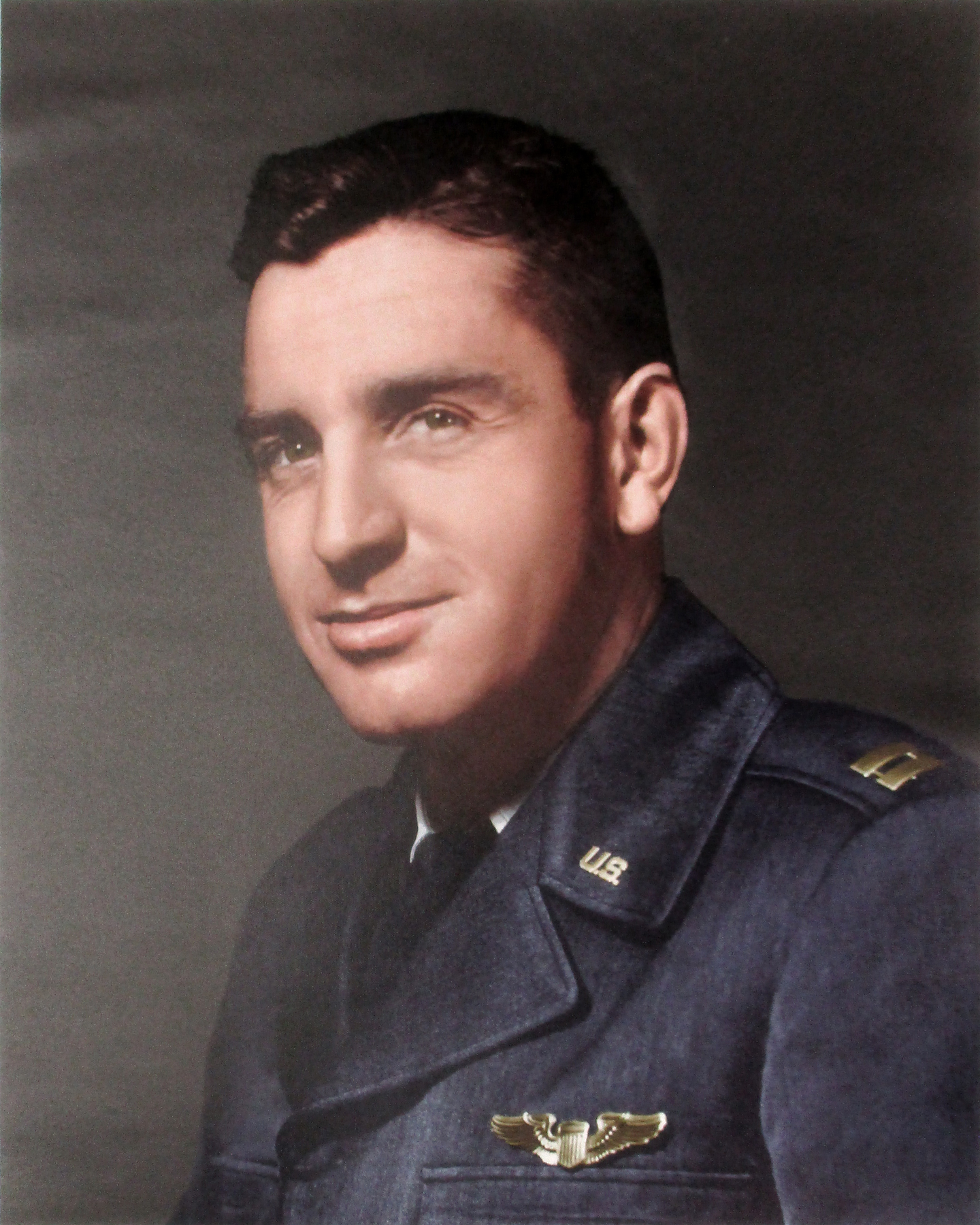
Captain Melvin E. Caughlin
Captain Melvin “Mel” E. Caughlin was born in Girard, PA on June 11, 1925. He grew up on a farm there during the Great Depression, began working before he was school-age, and later worked on the farm before and after school, amongst other jobs. In 1943, Mel enlisted in the U.S. Army Air Forces (which later became the United States Air Force or USAF).
During WWII, Mel was a radio operator and a tail gunner on B-17 “Flying Fortress” Bombers with the 351st Bomb Squadron, 100th Bomb Group, also known as The Bloody Hundredth (more details about their missions along with photos can be found on The Bloody Hundredth Bomb Group Foundation web site). He completed approximately 35 missions from 1944 to early 1945. After WWII ended, they dropped supplies from planes in Holland and then returned Displaced Persons (DPs) to their homelands. Following the returning of DPs, Mel entered the USAF Reserves.
Mel was in a B-29 “Superfortress” outfit from 1946-47 in Tampa, FL. He then entered pilot training at Randolph Field in San Antonio, TX; after which he became part of a Troop Carrier outfit in Greenville, SC flying C-82s and dropping paratroopers. Later he relocated to Nashville, TN and flew C-119s. In late 1950, during the Korean Conflict, Mel was stationed in Japan for about 16 months and then in Korea itself for about 6 months. Mel flew the Douglas A-26 “Invader” and completed 55 “Night Intruder” missions from September 1950 to May 1952 as part of the 8th Bomb Squadron. In June of 1952, Mel traveled to the Pentagon and requested reassignment for training to fly the new North American F-86 “Sabre.” His request was approved and he joined the 75th “Tiger Sharks” Fighter Interceptor Squadron (designed to protect the US from any potential bomber strikes). At this time, he also trained on F-86D “Sabre Interceptor.”
Mel met the love of his life, Mary F. Haskins in Valdosta, GA in May of 1953. After a 12-day courtship, Mel proposed because he was leaving on another assignment and did not wish to leave without her. They were married over 56 years (until his death) and had had 3 daughters. Mel stayed with the 75th until his honorable discharge in 1957 after almost 15 years of service in the USAF. Some of Mel’s decorations and citations were as follows; Air Medal w/9 Oak Leaf Clusters, European African Middle Eastern Theater Service Medal w/3 Bronze Stars, American Theater Ribbon, World War II Victory Medal, Distinguished Flying Cross, Distinguished Unit Citation, Korean Service Medal, United Nations Service Medal, and National Defense Service Medal. Our family has always been very proud of my dad and his service in the USAF! After being discharged, Mel became a commercial pilot for Eastern Airlines (EAL). During the Vietnam War, he flew Military Airlift Charters (“the MAC”) for EAL to deliver supplies to Vietnam and for the rest of his career with Eastern, he mainly flew the Boeing 727 and eventually the Airbus A300. Mel had lived in Long Island, NY for a few years, but he and his family moved to Miami, FL where he and his wife lived for over 45 years. Shortly thereafter, he was promoted to Captain and continued to fly for Eastern Airlines for 25 years, retiring in 1982. Mel had a distinguished career in flying both military and commercial planes spanning four decades and never wanted to retire from flying, but alas, it was mandatory. Mel always said he was more comfortable in the air than on the ground!
Mel had two loves in his lifetime; his family and flying! And having grandchildren was a real blessing after his retirement. He enjoyed every moment he had with them! Unfortunately, Mel suffered from a lengthy battle with Alzheimer's Disease in his later years. He passed away at the age of 84 on October 10, 2009. He was survived by his devoted wife, 3 daughters, 2 son-in-laws, and 4 grandchildren. Mel could have been buried in Arlington National Cemetery, but elected instead to be buried in his wife's family church cemetery. He was honored by the USAF with a military funeral.
My dad, Mel, overcame so many challenges from his early years working during the Great Depression, to his survival in aerial combat during the Second World War and the Korean Conflict, to his lifelong devotion to providing his family with a better life than he had. We thank Erie International Airport for honoring him and so many others who richly deserve it! And we are so grateful to my dad, Mel, for everything he did and we love and miss him every day! -Stacey & Brandon Rego
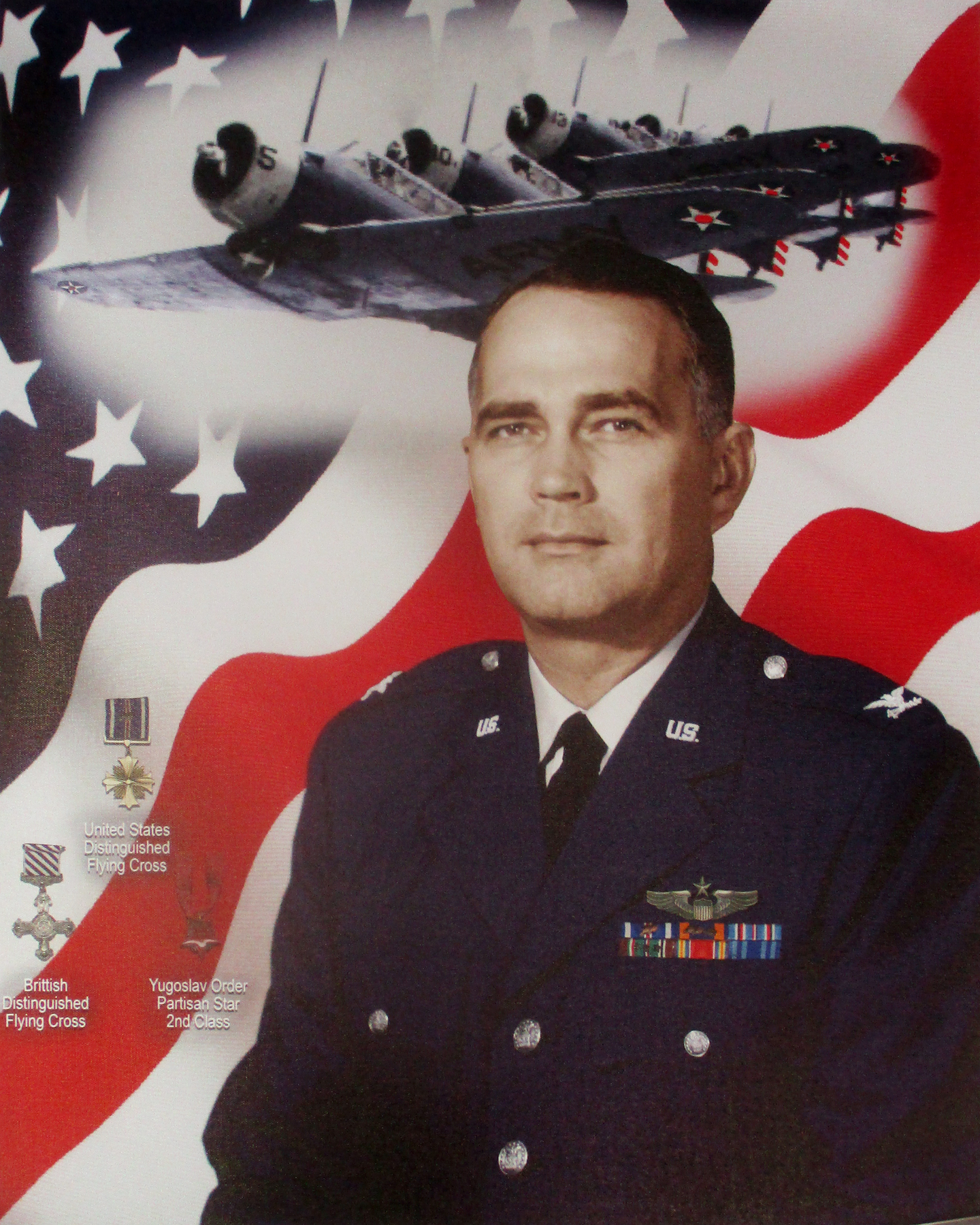
Colonel Lee D. Carr
Colonel Lee D. Carr was born in Mount Clemens, Michigan on January 13, 1921 the son of Leigh and Frances Carr. He graduated from Mt. Clemens High School in 1937. He earned a Bachelor of Science in Chemical Engineering with Honors in 1946 from Michigan Collage of Mining and Technology followed by a Master of Science in Chemical Engineering in 1949 from Massachusetts Institute of Technology (MIT).
Lee was an aviation cadet at the Gulf Coast Air Corps Training Center, Randolph Field, Texas graduating as a pilot in 1941. He was then commissioned 2nd Lieutenant on January 13, 1942 and assigned to Patterson Field, Fairfield, Ohio.
On June 27, 1942 Lee was assigned to the European Theatre of Operations flying C-47s. This included missions to southern France, Sicily, Tunisia, Algeria-French Morocco, Naples-Foggia, Rome-Arno and air combat in the Balkans.
During his service in WWII Lee was awarded an Air Medal with 3 Oak Leaf Clusters, The American Distinguished Flying Cross with 2 Oak leaves, The British Distinguished Flying Cross, and European-African-Middle Eastern Theatre Ribbon with 7 battle stars.
On July 13, 1943 while carrying both American and British paratroopers to Sicily Lt. Carr’s plane was heavily damaged by enemy fire requiring him to put the plane down into the sea. He then led the remaining troops aboard to safety through enemy territory. For this he was awarded both the American and British Distinguished Flying Crosses.
Lee’s war combat record as a pilot engaged in troop-ferrying with the 60th Troop Carrier Group/10th Squadron in enemy areas extending from North Africa, Sicily and Salerno and into the Balkan countries where his efforts were valuable to the partisans aiding the allied cause. One of Lee’s fondest wartime memories was of a mission in 1944 where he flew Marshal Tito off a mountain when Tito was being surrounded by the Germans. This heroic act enabled Marshal Tito to become President of Yugoslavia in 1953. Lee received the Yugoslavian Partisan Star 2nd Class Medal in 1945 for his efforts.
Another special memory Lee had was of a return flight to Tunisia where he found a downed American bomber crew in a raft in the Mediterranean. After dropping supplies to those in the raft he messaged a British destroyer of their position resulting in the rescue of eight members of the 320th bomb group. In 2009 he spoke with a few of the surviving wives who wanted to personally thank him for saving their husband’s lives that day.
After the war Lee continued his Air Force career in the Reserves at Hickam Air Force Base, Honolulu, Hawaii retiring in 1966.
Lee worked as a Chemical Engineer for Dole Corporation in Honolulu, Hawaii, Marketing Director for American Cyanamid in New Jersey and Mitsui Cyanamid in Tokyo, Japan.
Lee married Cheryle Roberts Carr on November 10, 1979. They lived in Tokyo, Japan and Houston, Texas and returned to Erie in 1995. Lee passed away on July 13, 2009 and is interred at Gate of Heaven Mausoleum, Erie, Pa.
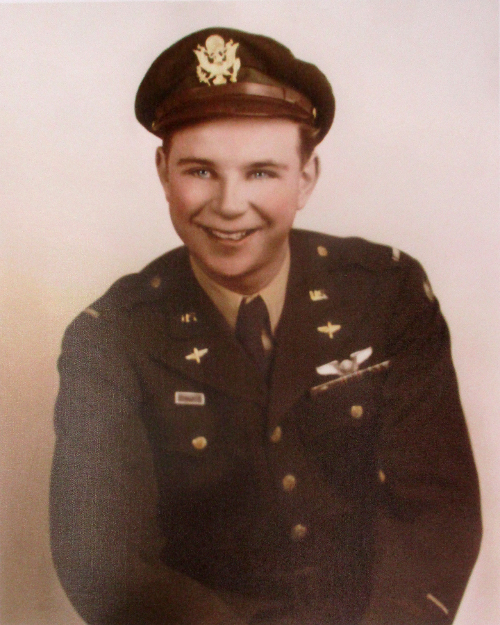
First Lieutenant Raymond A. Guerrein
Raymond A. Guerrein was born on September 5th, 1924 to Leopold Guerrein. and Anna W. Guerrein in Erie, PA. Guerrein graduated from Academy High in 1942 and entered Gannon University to pursue a degree in Chemistry. But from a young age, he had a fascination with flying.
In an excerpt from his published diary of his WWII missions, Guerrein writes “I think it all started back in 1931 when I was in second grade. Since my older brother ran a local movie theater in Erie, PA, I was able to see lots of shows and this particular one stuck with me. It was a silent movie, entitled, “Wings”, about WWI dog fights, Spads & Fokers, and starred Clara Bow, Richard Arlen, Buddy Rogers & Gary Cooper. After seeing this movie, I knew I would be flying some day.”
When December 7, 1941 hit, Guerrein was 17 and a senior in high school. Like every American of that time, he was shocked and filled with an extreme sense of patriotism. He had finished his first semester of college at Gannon and on November 5, 1942, enlisted in the Army Aviation Cadets, awaiting a call-up to active duty. That letter from the War Department eventually arrived the next spring and he reported to the Classification Center in Nashville, TN on April 11, 1943. In mid-August, following basic, flight and navigation training, he and his other crew members met in Lincoln, NE and picked up a “hot-off-the-assembly-line” B-17G for their trip to war-ravaged England. Guerrein often said that he was proud to have been in the Army Aviation Corp. where he participated in thirty-five bombing missions during 1944-1945, as a Navigator with the Eighth’s 96th Bomb Group, 339th Squadron, stationed in Snetterton Heath, near Norwich in eastern England.
After completing his required missions, he was honorably discharged from the Army Aviation Corp. and came back to Erie, PA to complete his degree in Chemistry. In his senior year of college, he attended a mixer at Villa Marie College, where he met Joan K. Marsh, the love of his life. They married in 1948 and had nearly 66 years of wedded bliss until his death on February 3, 2014. They were blessed with three children and four grandchildren.
Guerrein went on to receive his Master’s degree in organic chemistry in 1950 from Case Western Reserve in Cleveland, OH. He worked as a rubber chemist in several companies over the years, finally finishing his career as Plant Manager of Anchor Continental in Columbia, SC. After retirement, he taught Chemistry for a few years and was also active in DHEC and Waste Reduction Partners in SC and NC. He was an avid bridge player, crossword puzzle fanatic and bowler.
Mr. Guerrein received many awards during his life. He was recognized by the Senate of SC for his efforts toward environmental improvement in 1994. He was the President of the Five Points Rotary Club in Columbia, SC from 1978-1979. He was a Paul Harris Fellow for Rotary International. He was on the Board of Advisors for Mt. St. Mary’s Hospital, Niagara Falls, NY. He was also on the Board of Directors for Handicapped Workshop, Columbia, SC.
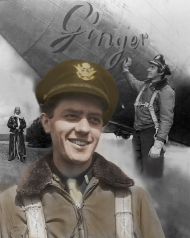
Lieutenant Colonel Michael Mashyna
Lt. Colonel Michael "Mike" Mashyna was born December 8th, 1921 to Russian and Czechoslovakian immigrant parents Philip and Mary. He had one younger brother, Philip John. He grew up on Erie's East side at 822 Pennsylvania Ave. and graduated from Tech high school in 1940 where he was president of his class and a photographer for the year book, photography being a lifelong interest.
Mike's 20th birthday was the day after the Pearl Harbor attack on Dec. 7th, 1941. He wanted to sign up for the service but his parents were reluctant to give their permission so when he turned 21 in 1942 he was able to join the Army Air Corp beginning basic training in Miami Beach in February 1943. By then Mike had met the love of his life, Genevieve "Ginger" Gorniak also from Erie and they were engaged that same month before he left.
In April of 1943 he arrived in Toledo, Ohio to attend Toledo University for officer and flight training and took off on his first flight for the Army Air Corp on June 8th. He was appointed an aviation cadet in July of that year. He spent time training in Alabama, Georgia and Mississippi graduating as a 2nd Lieutenant pilot at Columbus, Mississippi April 15th, 1944. While home on leave Mike and Ginger were married on April 24th, and left that same day for Sebring, Florida where he began piloting a B-17 Bomber, known as the "Flying Fortress" that later was painted with the name "Ginger" on its nose.
Mike and his 10-man crew, part of the 8th Air Force 100th Bomb Group finally flew overseas and were stationed out of Thorpe Abbotts base in England where they flew 35 combat missions without mishap bombing marshalling fields and rail lines among other targets mainly in Germany. He would send home an issue of "Stars and Stripes" as a code after each successful mission to let Ginger and the family know how close he was to completing the required number of missions. A diploma called "The Lucky Bastard Club" was presented to combat airmen who were fortunate enough to complete 35 missions. Statistics bear out that in the early days only 1 out of every 3 B-17s survived 25 missions. Mike received one of these diplomas while piloting with the 100th, called the "Bloody Hundredth" because the group sustained very high losses on a number of combat missions. On one mission a piece of flak flew into his plane, hit the wheel, bounced off and hit his knee. When he picked it up the chunk of metal was still hot.
Mike received the Air Medal with 5 oak leaves for combat missions over Europe and the European Theater Ribbon with 3 battle stars for participation in 3 major campaigns in Europe.
Following his tour in Europe, Mike went through flight instructor and aircraft maintenance school. He instructed several classes of West Point pilots and other Air Force personnel. Based out of Mobile, Alabama he also flew civilian and military personnel and freight all over the U.S.
After separation from Active Duty, he went into the Active Reserve program, flying out of Niagara Falls, N.Y. becoming Commander of the 9205th Erie Air Force Reserve. Returning to Erie, Mike received a degree in business administration from Gannon College in 1950 and he and Ginger had 4 children: Patricia, Michael, Phyllis, and Matthew.
Always interested in improving aviation in Erie, he participated in at least 3 air shows held at the Erie Airport carrying passengers on sight seeing tours over the city. He also served on the Erie Airport Authority Board for 17 years from 1969 to 1986.
Mike worked at various industries in Erie including Kaiser Aluminum and Hammermill Paper Co. before opening the U Frame It picture framing business in 1975. He enjoyed working there until his death in 1988.
Mike was very proud of his service to the country and would often tell stories about his time during the War. Fortunately, he was able to get back together with many members of the 100th Bomb Group at a couple of reunions to reminisce. He was also able to visit Pearl Harbor, the site of that fateful event that drew the U.S. into WWII and him to his destiny.
After his crew's 35th and final mission, Mike recorded in his journal how they were greeted by the ground crew with 3 bottles of liquor when they arrived safely back at the base. They "got the boys together by the nose of the ship and said a prayer thanking God for helping us make it... They had been thru all kind of hell during three of the hardest months of their lives and they deserved to celebrate being alive when they saw death staring them in the face more than once. Thank God I was able to bring them all back every time."

